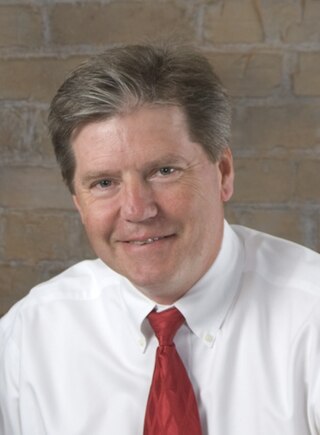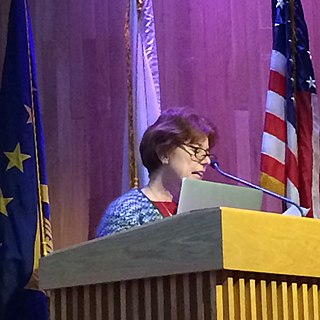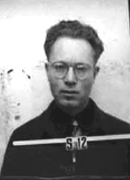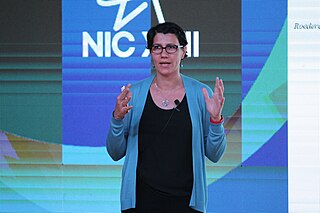Related Research Articles

A cyclotron is a type of particle accelerator invented by Ernest Lawrence in 1929–1930 at the University of California, Berkeley, and patented in 1932. A cyclotron accelerates charged particles outwards from the center of a flat cylindrical vacuum chamber along a spiral path. The particles are held to a spiral trajectory by a static magnetic field and accelerated by a rapidly varying electric field. Lawrence was awarded the 1939 Nobel Prize in Physics for this invention.

The National Superconducting Cyclotron Laboratory (NSCL), located on the campus of Michigan State University was a rare isotope research facility in the United States. Established in 1963, the cyclotron laboratory has been succeeded by the Facility for Rare Isotope Beams, a linear accelerator providing beam to the same detector halls.

Alexei Alexeyevich Abrikosov was a Soviet, Russian and American theoretical physicist whose main contributions are in the field of condensed matter physics. He was the co-recipient of the 2003 Nobel Prize in Physics, with Vitaly Ginzburg and Anthony James Leggett, for theories about how matter can behave at extremely low temperatures.

Karl-Ludwig Kratz is a German nuclear chemist and astrophysicist. He is professor for nuclear chemistry at the Johannes Gutenberg University of Mainz and adjunct professor of physics at the University of Notre Dame in South Bend, Indiana.
Gregory Scott Boebinger was the director of the National High Magnetic Field Laboratory in Tallahassee, Florida, and is currently a professor of physics at Florida State University.

Godfrey Harry Stafford CBE, FRS, was a British physicist and directed the Rutherford Appleton Laboratories from 1969 to 1981. He went on to be a master at St Cross College, Oxford and president of the Institute of Physics. In 1950 Dr. Stafford married Helen Goldthorp Clark, an Australian biologist. He has a son and twin daughters and lived near Oxford.
Juan Carlos Campuzano is a Paraguayan American physicist. He is a Distinguished Professor of Physics at the University of Illinois at Chicago. He was a Distinguished Fellow at Argonne National Laboratory, and a he is also a 2001 American Physical Society Fellow and a recipient of the 2011 Oliver Buckley Prize in Condensed Matter Physics. He is an expert in high-temperature superconductivity.

Hendrik Schatz is a professor of Nuclear Astrophysics at Michigan State University. He earned his Diploma from the University of Karlsruhe in 1993, and his PhD from the University of Heidelberg in 1997 after completing his thesis work at the University of Notre Dame. He is one of the Principal Investigators for the Joint Institute for Nuclear Astrophysics and is a leading expert on nuclear astrophysics,. Schatz also serves the science advisory committees for the Facility for Rare Isotope Beams and GSI. Hendrik's primary field of expertise is Type I X-ray Bursts. His most notable contribution to this field is the discovery of the SnTeSb-cycle. Hendrik was featured in Science magazine November 22, 2002 for his work on experimental nuclear astrophysics. Hendrik has also contributed to Physics Today.

Wolfgang W. Bauer is a university distinguished professor in the department of physics and astronomy at Michigan State University. He is also an author, with co-author Gary Westfall, of the introductory calculus-based physics textbook "University Physics", published by McGraw-Hill in 2023.

Gary D. Westfall is an American experimental nuclear and high energy physicist and University Distinguished Professor at Michigan State University. He is also a co-author, with Wolfgang Bauer, of the introductory calculus-based physics textbook University Physics, published by McGraw-Hill in 2010.

Barbara Jacak is a nuclear physicist who uses heavy ion collisions for fundamental studies of hot, dense nuclear matter. She is director of the Nuclear Science Division, Lawrence Berkeley National Laboratory, and a professor of physics at UC Berkeley. Before going to Berkeley, she was a member of the Department of Physics and Astronomy at Stony Brook University, where she held the rank of distinguished professor. She is a leading member of the collaboration that built and operates the PHENIX detector, one of the large detectors that operated at the Relativistic Heavy Ion Collider at Brookhaven National Laboratory, and was involved in the discovery of the quark gluon plasma and its strongly coupled, liquid-like behavior. Throughout her career she has served on many advisory committees and boards, including the National Research Council Committee on Nuclear Physics, and the Physical Review C editorial board.

Bernard Waldman was an American physicist who flew on the Hiroshima atomic bombing mission as a cameraman during World War II.
Robert Graham Hamish Robertson is a Canadian–American experimental physicist, specializing in neutrino physics. He is a Professor Emeritus at the University of Washington, where he was formerly the director of the University of Washington's Center for Experimental Nuclear Physics and Astrophysics.
Bradley Marc Sherrill is a Distinguished Professor of Physics at Michigan State University.
Sherry J. Yennello is an American nuclear chemist and an Elected Fellow of the American Association for the Advancement of Science. She is a Regents Professor and the holder of the Cyclotron Institute Bright Chair in Nuclear Science, who currently serves as the Director of the Cyclotron Institute at Texas A&M University. She is also a Fellow of the American Chemical Society and the American Physical Society. She has authored as well as co-authored more than 530 peer reviewed journal articles and has conducted many invited talks, presentations and seminars at several prestigious academic conferences and scholarly lectures.

Artemisia (Artemis) Spyrou is an experimental nuclear astrophysicist and professor at Michigan State University. She is also the Associate Director for Education and Outreach at the National Superconducting Cyclotron Laboratory. She was the recipient of a NSF CAREER Award.

Walter Benenson is a university distinguished professor emeritus in the department of physics and astronomy at Michigan State University. He retired in 2008, but continued to teach for another 10 years.
Adriaan van der Woude was a Dutch nuclear physicist, known as a leading expert on giant resonances.
Henry "Hank" Gabriel Blosser was an American nuclear physicist, known as a director for designing and building superconducting cyclotrons.
Alexandra Gade is a nuclear physicist who studies the nuclear structure of heavy elements, exotic nuclei, and rare isotopes, using techniques including nuclear spectroscopy, nucleon knockouts, and Coulomb excitation. Educated in Germany, she works at Michigan State University in the US as a professor of physics in the department of physics and astronomy and as deputy scientific director of the facility for rare isotope beams.
References
- ↑ "Scott Pratt". Michigan State University. Retrieved 22 May 2022.
- ↑ "Scott Pratt". National Superconducting Cyclotron Laboratory, Michigan State University. Retrieved 22 May 2022.
- ↑ "APS fellow archive". American Physical Society. Retrieved 22 May 2022.